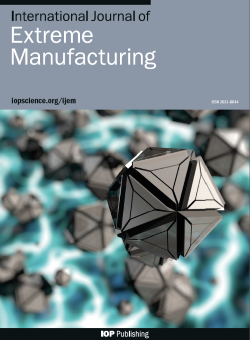3D printed grafts with gradient structures for organized vascular regeneration
IF 16.1
1区 工程技术
Q1 ENGINEERING, MANUFACTURING
引用次数: 0
Abstract
Synthetic vascular grafts suitable for small-diameter arteries (< 6 mm) are in great need. However, there are still no commercially available small-diameter vascular grafts (SDVGs) in clinical practice due to thrombosis and stenosis after in vivo implantation. When designing SDVGs, many studies emphasized reendothelization but ignored the importance of reconstruction of the smooth muscle layer (SML). To facilitate rapid SML regeneration, a high-resolution 3D printing method was used to create a novel bilayer SDVG with structures and mechanical properties mimicking natural arteries. Bioinspired by the collagen alignment of SML, the inner layer of the grafts had larger pore sizes and high porosity to accelerate the infiltration of cells and their circumferential alignment, which could facilitate SML reconstruction for compliance restoration and spontaneous endothelialization. The outer layer was designed to induce fibroblast recruitment by low porosity and minor pore size and provide SDVG with sufficient mechanical strength. One month after implantation, the arteries regenerated by 3D-printed grafts exhibited better pulsatility than electrospun grafts, with a compliance (8.9%) approaching that of natural arteries (11.36%) and significantly higher than that of electrospun ones (1.9%). The 3D-printed vascular demonstrated a three-layer structure more closely resembling natural arteries while electrospun grafts showed incomplete endothelium and immature SML. Our study shows the importance of SML reconstruction during vascular graft regeneration and provides an effective strategy to reconstruct blood vessels through 3D-printed structures rapidly.用于有组织血管再生的梯度结构 3D 打印移植物
目前急需适用于小直径动脉(小于 6 毫米)的合成血管移植物。然而,由于体内植入后出现血栓和血管狭窄,目前临床上仍没有市售的小直径血管移植物(SDVGs)。在设计 SDVGs 时,许多研究都强调再内皮化,却忽视了重建平滑肌层(SML)的重要性。为了促进平滑肌层的快速再生,我们采用了一种高分辨率三维打印方法,制造出了一种具有模仿天然动脉结构和机械性能的新型双层 SDVG。受SML胶原排列的生物启发,移植物的内层具有较大的孔径和较高的孔隙率,以加速细胞的浸润和周向排列,从而促进SML重建以恢复顺应性和自发内皮化。外层的设计是通过低孔隙率和小孔径来诱导成纤维细胞的募集,并为 SDVG 提供足够的机械强度。植入一个月后,三维打印移植物再生的动脉比电纺移植物表现出更好的搏动性,顺应性(8.9%)接近天然动脉(11.36%),明显高于电纺移植物(1.9%)。三维打印血管显示出更接近天然动脉的三层结构,而电纺移植物则显示出不完整的内皮和不成熟的 SML。我们的研究表明了血管移植物再生过程中SML重建的重要性,并提供了一种通过三维打印结构快速重建血管的有效策略。
本文章由计算机程序翻译,如有差异,请以英文原文为准。
求助全文
约1分钟内获得全文
求助全文
来源期刊

International Journal of Extreme Manufacturing
Engineering-Industrial and Manufacturing Engineering
CiteScore
17.70
自引率
6.10%
发文量
83
审稿时长
12 weeks
期刊介绍:
The International Journal of Extreme Manufacturing (IJEM) focuses on publishing original articles and reviews related to the science and technology of manufacturing functional devices and systems with extreme dimensions and/or extreme functionalities. The journal covers a wide range of topics, from fundamental science to cutting-edge technologies that push the boundaries of currently known theories, methods, scales, environments, and performance. Extreme manufacturing encompasses various aspects such as manufacturing with extremely high energy density, ultrahigh precision, extremely small spatial and temporal scales, extremely intensive fields, and giant systems with extreme complexity and several factors. It encompasses multiple disciplines, including machinery, materials, optics, physics, chemistry, mechanics, and mathematics. The journal is interested in theories, processes, metrology, characterization, equipment, conditions, and system integration in extreme manufacturing. Additionally, it covers materials, structures, and devices with extreme functionalities.
 求助内容:
求助内容: 应助结果提醒方式:
应助结果提醒方式:


